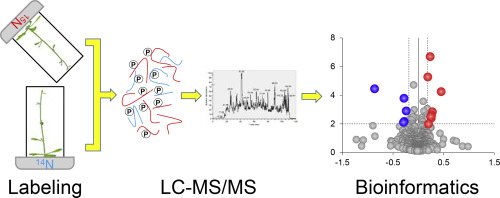当前位置:
X-MOL 学术
›
J. Proteomics
›
论文详情
Our official English website, www.x-mol.net, welcomes your
feedback! (Note: you will need to create a separate account there.)
The change of gravity vector induces short-term phosphoproteomic alterations in Arabidopsis.
Journal of Proteomics ( IF 2.8 ) Pub Date : 2020-02-28 , DOI: 10.1016/j.jprot.2020.103720 Zhu Yang 1 , Guangyu Guo 2 , Nan Yang 2 , Sunny Sing Pun 2 , Timothy Ka Leung Ho 2 , Ling Ji 3 , Inch Hu 4 , Jianhua Zhang 5 , Alma L Burlingame 6 , Ning Li 7
Journal of Proteomics ( IF 2.8 ) Pub Date : 2020-02-28 , DOI: 10.1016/j.jprot.2020.103720 Zhu Yang 1 , Guangyu Guo 2 , Nan Yang 2 , Sunny Sing Pun 2 , Timothy Ka Leung Ho 2 , Ling Ji 3 , Inch Hu 4 , Jianhua Zhang 5 , Alma L Burlingame 6 , Ning Li 7
Affiliation

|
Plants can sense the gravitational force. When plants perceive a change in this natural force, they tend to reorient their organs with respect to the direction of the gravity vector, i.e., the shoot stem curves up. In the present study, we performed a 4C quantitative phosphoproteomics to identify those altered protein phosphosites resulting from 150 s of reorientation of Arabidopsis plants on earth. A total of 5556 phosphopeptides were identified from the gravistimulated Arabidopsis. Quantification based on the 15N-stable isotope labeling in Arabidopsis (SILIA) and computational analysis of the extracted ion chromatogram (XIC) of phosphopeptides showed eight and five unique PTM peptide arrays (UPAs) being up- and down-regulated, respectively, by gravistimulation. Among the 13 plant reorientation-responsive protein groups, many are related to the cytoskeleton dynamic and plastid movement. Interestingly, the most gravistimulation responsive phosphosites are three serine residues, S350, S376, and S410, of a blue light receptor Phototropin 1 (PHOT1). The immunoblots experiment confirmed that the change of gravity vector indeed affected the phosphorylation level of S410 in PHOT1. The functional role of PHOT1 in gravitropic response was further validated with gravicurvature measurement in the darkness of both the loss-of-function double mutant phot1phot2 and its complementary transgenic plant PHOT1/phot1phot2. SIGNIFICANCE: The sessile organisms, plants, are able to move in response to environmental stimuli, such as gravity vector, touch, light, water, or nutrients, which is termed tropism. For instance, the bending of plant shoots to the light source is called phototropism. Since all plants growing on earth are continuously exposed to the gravitational field, the gravitropic response of plants receives the mechanical signal elicited by the gravity vector and regulates plant morphogenesis, growth, and development. Past studies have resulted in various hypotheses for gravisensing, but our knowledge about how the signals of plant reorientation are transduced in plant cells is still minimal. In the present study, we performed a SILIA-based 4C quantitative phosphoproteomics on 150-s gravistimulated Arabidopsis seedlings to explore the phosphoproteins involved in the gravitropic response. Our data demonstrated that such a short-term reorientation of Arabidopsis caused changes in phosphorylation of cytoskeleton structural proteins like Chloroplast Unusual Positioning1 (CHUP1), Patellin3 (PATL3), and Plastid Movement Impaired2 (PMI2), as well as the blue light receptor Phototropin1 (PHOT1). These results suggested that protein phosphorylation plays a crucial role in gravisignaling, and two primary plant tropic response, gravitropism and phototropism, may share some common components and signaling pathways. We expect that the phosphoproteins detected from this study will facilitate the subsequent studies on the mechanism underlying the signal transduction in plant gravitropic response.
中文翻译:

重力矢量的变化诱导拟南芥中的短期磷酸化蛋白质组学改变。
植物可以感应到重力。当植物感知到这种自然力的变化时,它们倾向于相对于重力矢量的方向重新定向它们的器官,即枝干弯曲。在本研究中,我们进行了4C定量磷酸化蛋白质组学,以鉴定由拟南芥植物在地球上重新定位150 s引起的那些蛋白质磷酸化位点的改变。从重刺激的拟南芥中鉴定出总共5556种磷酸肽。基于拟南芥中15N稳定同位素标记的定量(SILIA)和磷酸肽的提取离子色谱图(XIC)的计算分析表明,通过重力刺激分别上调和下调了八个和五个独特的PTM肽阵列(UPA)。 。在13个植物定向应答蛋白组中,许多与细胞骨架动力学和质体运动有关。有趣的是,最受去刺激的反应性磷酸位点是蓝光受体Phototropin 1(PHOT1)的三个丝氨酸残基S350,S376和S410。免疫印迹实验证实重力载体的改变确实影响了PHOT1中S410的磷酸化水平。PHOT1在重力反应中的功能作用通过在黑暗中功能丧失的双重突变体phot1phot2及其互补转基因植物PHOT1 / phot1phot2的黑暗中的重力曲面测量得到了进一步验证。意义:无柄生物(植物)能够响应环境刺激而移动,例如重力矢量,接触,光,水或营养,这被称为向向性。例如,植物芽弯曲到光源称为向光性。由于地球上生长的所有植物都不断暴露于重力场中,因此植物的重力响应接收重力矢量引发的机械信号,并调节植物的形态发生,生长和发育。过去的研究得出了各种各样的假设,但是我们对如何在植物细胞中转导植物定向信号的知识仍然很少。在本研究中,我们对150 s重力刺激的拟南芥幼苗进行了基于SILIA的4C定量磷酸化蛋白质组学,以探索与重力反应有关的磷蛋白。我们的数据表明,这种拟南芥的短期重新定位导致细胞骨架结构蛋白(如叶绿体异常定位1(CHUP1),Patellin3(PATL3)和质体运动障碍2(PMI2))以及蓝光受体Phototropin1( PHOT1)。这些结果表明,蛋白质磷酸化在引力作用中起着关键作用,并且两种主要的植物趋向性反应,引力和光敏性,可能共享一些共同的成分和信号传导途径。我们期望从这项研究中检测到的磷蛋白将促进随后对植物重力反应中信号转导机制的后续研究。这些结果表明,蛋白磷酸化在引力作用中起着关键作用,并且两种主要的植物趋向性反应,引力和光敏性,可能共享一些共同的成分和信号传导途径。我们期望从这项研究中检测到的磷蛋白将促进随后对植物重力反应中信号转导机制的后续研究。这些结果表明,蛋白磷酸化在引力作用中起着关键作用,并且两种主要的植物趋向性反应,引力和光敏性,可能共享一些共同的成分和信号传导途径。我们期望从这项研究中检测到的磷蛋白将促进对植物重力反应中信号转导的潜在机制的后续研究。
更新日期:2020-03-02
中文翻译:

重力矢量的变化诱导拟南芥中的短期磷酸化蛋白质组学改变。
植物可以感应到重力。当植物感知到这种自然力的变化时,它们倾向于相对于重力矢量的方向重新定向它们的器官,即枝干弯曲。在本研究中,我们进行了4C定量磷酸化蛋白质组学,以鉴定由拟南芥植物在地球上重新定位150 s引起的那些蛋白质磷酸化位点的改变。从重刺激的拟南芥中鉴定出总共5556种磷酸肽。基于拟南芥中15N稳定同位素标记的定量(SILIA)和磷酸肽的提取离子色谱图(XIC)的计算分析表明,通过重力刺激分别上调和下调了八个和五个独特的PTM肽阵列(UPA)。 。在13个植物定向应答蛋白组中,许多与细胞骨架动力学和质体运动有关。有趣的是,最受去刺激的反应性磷酸位点是蓝光受体Phototropin 1(PHOT1)的三个丝氨酸残基S350,S376和S410。免疫印迹实验证实重力载体的改变确实影响了PHOT1中S410的磷酸化水平。PHOT1在重力反应中的功能作用通过在黑暗中功能丧失的双重突变体phot1phot2及其互补转基因植物PHOT1 / phot1phot2的黑暗中的重力曲面测量得到了进一步验证。意义:无柄生物(植物)能够响应环境刺激而移动,例如重力矢量,接触,光,水或营养,这被称为向向性。例如,植物芽弯曲到光源称为向光性。由于地球上生长的所有植物都不断暴露于重力场中,因此植物的重力响应接收重力矢量引发的机械信号,并调节植物的形态发生,生长和发育。过去的研究得出了各种各样的假设,但是我们对如何在植物细胞中转导植物定向信号的知识仍然很少。在本研究中,我们对150 s重力刺激的拟南芥幼苗进行了基于SILIA的4C定量磷酸化蛋白质组学,以探索与重力反应有关的磷蛋白。我们的数据表明,这种拟南芥的短期重新定位导致细胞骨架结构蛋白(如叶绿体异常定位1(CHUP1),Patellin3(PATL3)和质体运动障碍2(PMI2))以及蓝光受体Phototropin1( PHOT1)。这些结果表明,蛋白质磷酸化在引力作用中起着关键作用,并且两种主要的植物趋向性反应,引力和光敏性,可能共享一些共同的成分和信号传导途径。我们期望从这项研究中检测到的磷蛋白将促进随后对植物重力反应中信号转导机制的后续研究。这些结果表明,蛋白磷酸化在引力作用中起着关键作用,并且两种主要的植物趋向性反应,引力和光敏性,可能共享一些共同的成分和信号传导途径。我们期望从这项研究中检测到的磷蛋白将促进随后对植物重力反应中信号转导机制的后续研究。这些结果表明,蛋白磷酸化在引力作用中起着关键作用,并且两种主要的植物趋向性反应,引力和光敏性,可能共享一些共同的成分和信号传导途径。我们期望从这项研究中检测到的磷蛋白将促进对植物重力反应中信号转导的潜在机制的后续研究。











































 京公网安备 11010802027423号
京公网安备 11010802027423号